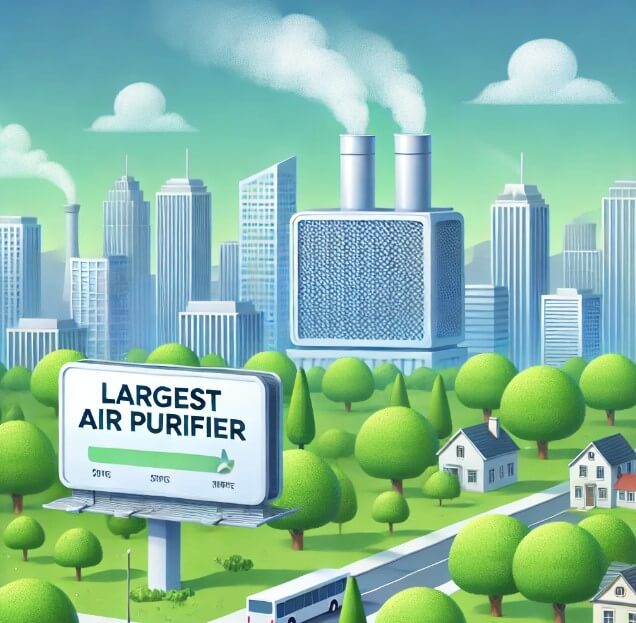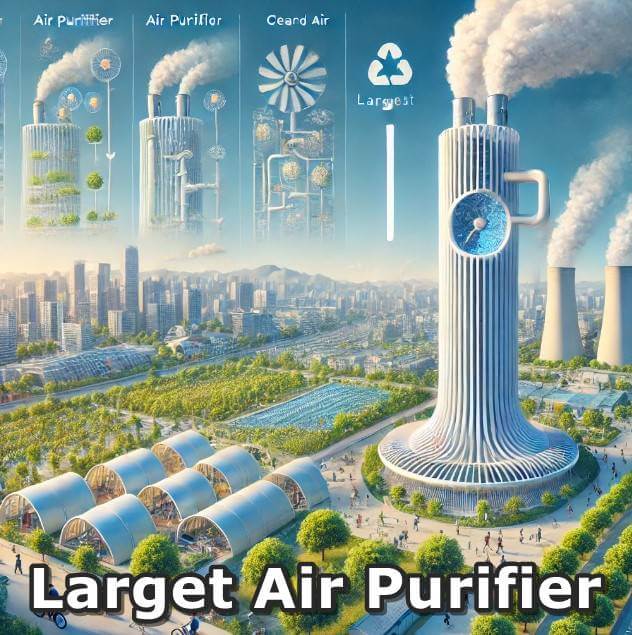Air pollution has become a global crisis, affecting millions of lives and the environment. With urbanization and industrial growth, air quality in many cities has deteriorated significantly, leading to various health concerns. In response to this pressing issue, the development of advanced air purification systems has become essential. One of the most remarkable innovations in this domain is the construction of the largest air purifier in the world, which has proven to be a game-changer in the fight against pollution. This article explores the largest air purifier, its design, functionality, impact, and future prospects.
What is the Largest Air Purifier in the World?
The world’s largest air purifier is located in Xi’an, a major city in northwestern China. This extraordinary structure, standing at 100 meters (328 feet) tall, is a symbol of hope in tackling air pollution. Known as the Xi’an Air Purification Tower, it was developed by the Institute of Earth Environment at the Chinese Academy of Sciences. This monumental project aims to filter out harmful pollutants and deliver cleaner, healthier air to the city’s residents.
The Need for the Largest Air Purifier

Before delving into the specifics of the world’s largest air purifier, it is crucial to understand the severity of air pollution and why such a project was necessary.
- Health Impacts: Air pollution is a leading cause of respiratory diseases, cardiovascular issues, and even premature death. According to the World Health Organization, air pollution causes approximately 7 million deaths worldwide each year.
- Economic Costs: Poor air quality also has a significant economic impact, reducing workforce productivity and increasing healthcare costs.
- Environmental Damage: Pollutants in the air can harm ecosystems, contribute to climate change, and damage the ozone layer.
Design and Structure of the Largest Air Purifier
The Xi’an Air Purification Tower features a unique design that combines solar energy and advanced filtration technologies. The entire system is divided into several key components:
1. Tower Structure
- Height: The tower is 100 meters tall, making it visible from various parts of the city.
- Diameter: The base of the tower is designed to optimize the intake of polluted air.
2. Greenhouses at the Base
- The base of the tower is surrounded by large greenhouses that cover an area of several square meters. These greenhouses act as the initial intake points for polluted air.
- How It Works: Polluted air is drawn into these greenhouses, where it is heated by solar energy. This heating process causes the air to rise naturally through the tower.
3. Filtration System
- As the heated air rises, it passes through multiple layers of high-efficiency air filters.
- These filters remove harmful particulates, such as PM2.5 and PM10, as well as other pollutants like carbon dioxide and nitrogen oxides.
4. Release of Purified Air
- Once the air has been filtered, it is released back into the atmosphere as clean, breathable air. The entire process is continuous, ensuring a steady flow of purified air.
How the Xi’an Air Purification Tower Works
The operation of the world’s largest air purifier is based on a simple yet effective principle: harnessing solar energy to drive natural air circulation. Here is a step-by-step breakdown of how the system works:
- Air Intake: Polluted air from the surrounding environment is drawn into the greenhouses at the base of the tower.
- Solar Heating: The air inside the greenhouses is heated using solar energy, which causes it to rise.
- Air Filtration: As the warm air rises through the tower, it passes through multiple filtration layers, removing harmful pollutants and particulates.
- Clean Air Release: The purified air is then released from the top of the tower, significantly improving the air quality in the surrounding area.
Performance and Effectiveness
Since its construction, the Xi’an Air Purification Tower has shown impressive results in improving air quality. Here are some key performance metrics:
- Reduction in PM2.5 Levels: Monitoring stations around the tower have recorded a 15-20% reduction in PM2.5 levels during heavy pollution periods. PM2.5 refers to fine particulate matter that poses serious health risks.
- Volume of Clean Air: The tower can produce over 10 million cubic meters (353 million cubic feet) of clean air daily, benefiting thousands of residents.
- Area of Impact: The air purification tower has a positive effect on air quality within a radius of several kilometers.
The Impact on Xi’an and Beyond
The world’s largest air purifier has had a transformative impact on Xi’an, a city that has long struggled with air pollution. Residents have reported clearer skies and an improvement in overall air quality. This project has also raised awareness about the importance of air purification and inspired similar initiatives worldwide.
Benefits of the Largest Air Purifier
- Health Improvements: Cleaner air reduces the risk of respiratory diseases, asthma, and other health conditions associated with pollution.
- Environmental Impact: By removing harmful pollutants, the tower helps mitigate the effects of smog and improves the city’s ecosystem.
- Economic Advantages: Better air quality can lead to increased productivity and lower healthcare costs.
Challenges and Limitations
While the largest air purifier is a groundbreaking innovation, it is not without challenges:
- Cost: The construction and maintenance of such a large structure require significant investment.
- Energy Use: Although the tower uses solar energy, there are concerns about the efficiency and sustainability of its operations.
- Scalability: Building similar towers in other cities would require careful planning and substantial financial resources.
Future Prospects and Developments
The success of the Xi’an Air Purification Tower has sparked interest in scaling up the technology. Researchers are exploring the possibility of constructing even larger towers that could purify air for entire cities. A proposed future model would stand at 500 meters tall and feature advanced filtration systems capable of removing even more pollutants.
Key Features of the World’s Largest Air Purifier
| Feature | Details |
|---|---|
| Location | Xi’an, Shaanxi Province, China |
| Height | 100 meters (328 feet) |
| Daily Air Purification | 10 million cubic meters |
| Pollutant Reduction | 15-20% reduction in PM2.5 levels |
| Energy Source | Solar energy |
| Coverage Area | Several kilometers radius |
Environmental Significance
The world’s largest air purifier serves as a testament to human ingenuity in the face of environmental challenges. It demonstrates the potential of using technology to create sustainable solutions for cleaner air and healthier living conditions. As cities continue to grow and pollution levels rise, innovations like these will play a crucial role in shaping the future of urban environments.
Related Innovations in Air Purification
Apart from the Xi’an Air Purification Tower, there are several other noteworthy air purification projects worldwide:
- Smog-Free Tower: Designed by Dutch artist Daan Roosegaarde, this tower uses ionization technology to remove smog particles from the air. It is significantly smaller than the Xi’an tower but has been deployed in cities like Beijing and Rotterdam.
- Air Quality Monitoring Systems: Advances in sensor technology have enabled real-time monitoring of air quality, helping to inform and protect the public.
FAQs about the Largest Air Purifier
What is the purpose of the largest air purifier in the world?
The purpose is to reduce air pollution by filtering out harmful particulates and improving air quality in urban areas.
How effective is the Xi’an Air Purification Tower?
It has been shown to reduce PM2.5 levels by 15-20% and produces over 10 million cubic meters of clean air daily.
What are the main components of the air purifier?
The main components include a 100-meter tall tower, greenhouses at the base, and a multi-layered filtration system.
Does the tower use renewable energy?
Yes, the tower uses solar energy to heat the air and drive the purification process.
Are there plans to build more air purifiers like this one?
Researchers are exploring the possibility of constructing larger towers in other cities to combat air pollution on a broader scale.
What challenges does the air purifier face?
Key challenges include the high cost of construction and maintenance, as well as questions about scalability and long-term efficiency.
Conclusion
The world’s largest air purifier is a remarkable feat of engineering that offers hope in the battle against air pollution. Its success in Xi’an serves as a model for future urban air purification projects, highlighting the potential of innovative technology to create healthier living environments. As the fight against air pollution continues, advancements like these will be essential in ensuring a sustainable future for our planet.
Visit GLOBEYA for more!



